The Corona crisis in 2020 showed how panic and greed dominate the markets. While in the spring of 2020 the market collapsed by almost 50 % as many seem to be selling without their heads and minds, many opportunities have presented themselves for long-term investors. Because the rebound lasted just 9 months. In order to take advantage of such opportunities in the future, I have created a ranking. The ranking of Best passive income strategies shows you which asset classes you can invest in to generate passive income. Corona crisis or not. As always, this time the ranking does not represent an invitation to buy or sell. Of course, you can still use the results for your further research on building up passive income.
To rank the top passive income strategies, I compared seven different passive income streams. The factors risk, return, liquidity, knowledge, effort and feasibility flow into the 6-factor model.
Of course, the assessments of the ranking are always somewhat subjective. But they come from my own experiences and therefore from real life.
The journey to passive income is a marathon. No sprint. However, thanks to progressive innovation, digitization and technical progress, there are now more opportunities to generate passive income than ever before.
The journey to passive income is a marathon. No sprint
The first step to passive income is saving
What you can learn here
- The first step to passive income is saving
- Make passive income comparable - the ranking!
- 1) Liquid investments: call money and time deposits
- 2) Passive income with real estate
- Despite rising prices, real estate is well suited for passive income
- 3) Passive income with broadly diversified ETFs
- ETFs in the corona crisis
- 4) Passive income with bonds
- 5) Passive income with mixed funds
- 6) Passive Income with Robo Advisor
- "Deposit Protection" in Robo Advisors
- 7) Build passive income with individual stocks
- Example dividend stocks
- Industry Dividend Stocks
- Passive income with dividend stocks
- Do not overweight individual stocks
- 8) Peer-to-Peer Lending (P2P)
- Complete table of the best passive income streams
- Invest early and regularly to build sustainable passive income!
As each of us knows, consumption is much more pleasant than saving. Spending money is made as easy as possible for us. Even for some multi-millionaires, the temptation to consume is so great that they squander their entire fortune and end up with nothing. Saving is more difficult. It means thinking ahead and restraining yourself in the now so that you can reap the rewards later in the form of passive income streams. Generating passive income is not difficult, but discipline and perseverance are necessary.
By far the most important reason to strive for passive income is to have enough money to do what you want, when you want. Financial freedom is the best!
Sounds good doesn't it? However, saving money is only the first step in building a passive income stream. It is even more important to know how to invest your savings profitably without being exposed to unnecessary risks. Even if a cash account great for a nest egg is a free checking account already helps to reduce unnecessary costs, they are not suitable investment vehicles. Because sometimes cash is king, I have also included in the ranking liquid investment options such as call money, fixed-term deposits, and checking account even though these are not actually investment vehicles.
Make passive income comparable - the ranking!
Below are seven investment vehicles, each of which are capable of generating passive income streams in their own way. Any passive income stream is after Risk, return, effort, knowledge, liquidity and feasibility classified. Each criterion is given a score between 1 and 4. The higher the score, the better. An exception is the yield. Since the other five criteria are opposed to yield, yield gets five times the number of points in the ranking. In addition, in order to also adequately take negative interest into account, scores between -10 and +20 are provided for the yield. In detail, the ratings mean the following:
- A risk score of 4 means no risk.
- A Yield Score of -10 means a negative yield and a Yield Score of +20 means the maximum possible yield
- An Effort rating of 4 means this is done quickly by anyone
- A worth knowing value of 4 means that almost no previous knowledge is required for this asset class
- The feasibility ranking factor takes into account initial costs and hurdles before the start, such as notary costs and a lengthy procedure when buying a property. A rating of 4 means that there are no initial costs or hurdles before starting the investment.
The scores are relative to each other. In this way, an evaluation that is as realistic as possible is aimed for. The criteria are suitable for people who aim for an annual passive income between 3,000 and 50,000 euros. Because the five criteria Risk, effort, knowledge, liquidity and feasibility the criterion yield face to face, the yield receives five times the number of points in the ranking.
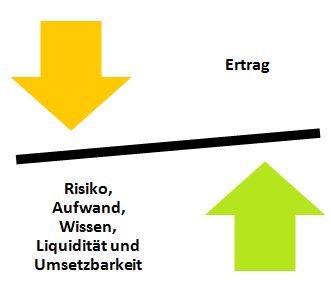
Let's start with the liquid investments, which actually do not represent a financial investment due to their low earning power. Nevertheless, a buffer for the unforeseen and as a liquidity cushion is important. Especially in times of the corona crisis, cash is king after all.
1) Liquid investments: per diem and fixed deposit
Before the financial crisis of 2009, there were high-yield money market accounts with over 5 % interest rates. We can only dream of that nowadays. Interest rates below 1 % are the order of the day even with good money market accounts. After all, as a European, you are no longer limited to German banks. The European deposit insurance fund of 100,000 euros protects you from all European banks. So it makes no difference whether the money is stored in a German or French bank. Currently, the French mymoneybank* good deals for savers. So you only get 0.3 % interest here, but there is an attractive bonus of up to 100 euros, graduated according to the investment amount. This effectively earns you around 0.5 % interest in the first year. There's nothing else anywhere else. You can access the account via interest rate pilot* to graduate. There are actually always good offers for call money and time deposits here.
The good thing about overnight and time deposit accounts: Anyone can go to a bank and open an account. The protection provided by the Europe-wide deposit protection fund can be increased by opening several overnight deposit accounts. However, such high cash reserves hardly make sense in the low-interest environment. The Inflation would only devastate the stocks.
On the other hand, a call money account with a positive interest payment in a zero-interest environment is a good thing for your cash reserve. After all, German government bonds have a negative interest rate of around 0.3 %. See the figure below. In contrast, 0.5 % interest at Zinspilot sounds almost heavenly.

Evaluation scale of all factors except yield: Rating 1-4, where 4 means most liquidity, least risk, least effort, least knowledge, and easiest to implement
Evaluation standard of yield: Rating yield from -10 (negative interest) to +20 (highest yield)
|
|
|
Rating of current account, money market account and time deposit account. Risk Rating: 4 (No Risk); Income rating: Negative because interest rates < inflation; Effort: 4 (opened online in 10 minutes), knowledge: 4 (no previous knowledge required), liquidity: current and call money accounts have maximum liquidity, hence 4 points. The fixed-term deposit account receives 2 points, since it is difficult to dissolve. Feasibility: 4 (full points, because really anyone can open such a damn account as a buffer *) Total score: 10-15
2) Passive income with real estate
Real estate is a good asset class for building wealth. The main advantages of real estate are that the concept is easy to understand. Furthermore, living space is also needed when the economic situation is poor, which means that demand is maintained even in downturns. In addition, you can easily leverage your income with borrowed capital in order to achieve an attractive return. The bad thing about owning real estate, on the other hand, is that it's not really a passive investment. There are always things that need to be done. In addition, dealing with tenants can be a real challenge and you have to be able to react quickly in the event of damage.
Another advantage of real estate is its protection against inflation. The price of real estate generally changes with inflation. While the cost of a once completed real estate loan remain constant over many years, the landlord benefits from rising rent levels, so that the profit from letting increases over the years. The great thing is that this happens automatically in good locations.
In order to realize a profit of 5,000 euros before taxes and reserves with a rental property, a property of around 100,000 euros is necessary. This corresponds to an interest rate of 5 %. However, since the 2009 financial crisis, there has been a continuous one Run on real estate. As a result, yields north of five percent are not always achievable in the major cities of Berlin, Munich, Hamburg, Cologne, Frankfurt, Stuttgart and Düsseldorf and their catchment areas. In some cases, the return on real estate in top locations is 2 % and less. In order to generate a profit of 5,000 euros per year, an investment of the order of 250,000 euros is necessary in top locations.
Despite rising prices, real estate is well suited for passive income
The rising prices are a sign that there is excess demand in the market. Due to the many cheap loans, the price of real estate has risen continuously. This means that real estate in top locations is mainly bought as a speculative object to increase value and less to generate income. This represents a higher risk than buying real estate based on actual rental income in the here and now.
In inexpensive cities such as the Ruhr area, the Eifel or in rural parts of eastern Germany, net rental yields can easily range from 7 % to 9 %.
Despite the rise in prices since 2009, real estate is still a lucrative investment due to the renewed fall in building interest rates in 2020. In addition, it is the only asset class that can be easily leveraged. For a good property, you can currently get a loan from many banks without any problems, even with an average income.
In summary, high effort, low liquidity, long-term planning and implementation are associated with real estate investments good returns and low risk rewarded.
|
Rating of real estate as an investment. Risk Rating: 3, Return Rating: 20 (high return through financing!), Effort: 1 (significantly more effort than other asset classes). Knowledge: 2 (Basic technical and commercial knowledge required). Liquidity: 1 (sale depends on the location. Even in good locations, the transaction takes several months), feasibility: 1. (many hurdles, high sunk costs such as broker, notary and land registry fees) Total score: 28
3) Passive income with broadly diversified ETFs
Broadly diversified ETFs are one of the simplest and most passive investment strategies out there. An ETF portfolio, you can do it with easy knowledge to be found on the internet complete and automate research in just a few evenings. If you still shy away from these few hours, it's worth it thinking about a ready-made algorithm that will do this work for you.
If you don't know how to buy a stock or security, Here you will find step-by-step instructions on how to buy your first share.
Anyone who was or is invested in shares during the corona crisis needs strong nerves – prices have plummeted. For long-term investments, there is therefore an opportunity that has not existed for a long time to invest cheaply in quality companies via ETFs. In another article we also identified further advantages of a crisis last week. The correct behavior in a financial crash is here written down.
ETFs in the corona crisis
Despite everything, the world economy will be able to overcome this crisis in a few weeks or months. I am convinced of that. Of the Vanguard FTSE All World Index (WKN:
A1JX52) with its around 3,900 positions from around 50 countries, this crisis will only show up as a dip in the future. 95 % of global invertible market capitalization, don't go down the drain in the long term because people stop going to work in the short term. In the short term, the corona crisis is causing great economic damage. Since the virus spreads exponentially, the danger is often underestimated. I as well would not have thought in mid-Februarythat it comes to this 4 weeks later.
But precisely because of the currently favorable entry options for widely diversified ETFs, you should stay on the ball here. If you feel comfortable with it, take the opportunity now to increase your portfolio at a reasonable price. If that's too hot for you, you could also increase the savings plan and thus benefit from the low prices.
|
Rating of broadly diversified ETFs. Risk rating: 3, return rating: 15 (in the long term approx. 5-7 %), effort: 3 (it's only easier with a robo advisor, which we will look at later). Knowledge: 2 (Medium rating - At first you have to deal with it a little, then almost not anymore). Liquidity: 2 (sale is always possible, but only with losses in the event of a crash) Feasibility: 4. (simple implementation) Total score: 29
For those interested, I recommend Vanguard ETFs. Thanks to their cooperative ownership structure, Vanguard can avoid conflicts of interest. Presumably also due to the cooperative structure, the provider was able to reduce the costs of the funds (TER) several times. The tracking difference (TD) of the Vanguard World ETF is also very low in a peer comparison.
by the way: Vanguard ETFs are over the smart broker* or the DKB* available. You can find more information about good depots in the Depot guide and comparison
4) Passive income with bonds
While we already have stock ETFs in previous chapter have considered, it should now be about their counterpart: the bonds. With a bond, you lend money to a company or the government. In return, you receive interest payments, also known as coupons, over the agreed period. For the company or the state (issuer), the bond represents an alternative to a bank loan. The issuer thus obtains capital and also has the advantage of having to provide less collateral than with a bank loan.
Bonds can also be grouped together as an ETF. Here, the ETF constantly buys bonds of a certain type and distributes the income, in this case the coupons, to the investors. For example, he buys iShares Core Euro Government Bond UCITS ETF (WKN: A0RL83) Bonds from European countries with all possible residual terms. The interest income is then distributed to investors every six months. The ishares ETF mentioned is, for example, at smart broker* (Fees: up to 400 EUR 0.80 EUR; above that: 0.2 % of the investment volume) or also Traderepublic* (free) available in the savings plan.
Below you can see a comparison of the average yield on government bonds from several euro countries with the current yield on ten-year government bonds. (Source: Pictet/ FAZ). The yields on euro government bonds are therefore between 2 and around 4.5 percent.
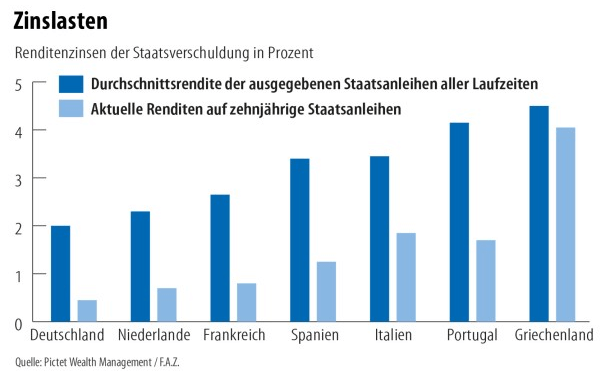
|
Rating of Bonds. Risk rating: 3, return rating: 15 (in the long term approx. 3-5 %), effort: 3 (it's only easier with a robo advisor, which we will consider later). Knowledge: 2 (Medium rating - At first you have to deal with it a little, then almost not anymore). Liquidity: 3 (sale is always possible, historically lower price losses than stock ETFs in times of crisis) Feasibility: 4. (simple implementation) Total score: 25
5) Passive income with mixed funds
Mixed funds are actively managed constructs in which an investment manager constantly adjusts the composition according to the market situation. It is therefore a mixture of company shares, bonds and, depending on the fund, one or the other commodity, such as gold. Defensively structured balanced funds are characterized by lower volatility because the investment manager switches the money into bonds should a crisis develop. The major disadvantage of these asset classes is the significantly above-average fees compared to other bonds in securities. In addition, it is difficult for fund managers - just like us - to predict developments on the stock market and to make decisions in good time. This regularly leads to fund managers not being able to generate an excess return compared to passive investments in the long term, which would justify their high salary. On the contrary: passively managed funds are often inferior to passive ETFs in terms of return and risk even behind.
Conclusion: Active funds were perhaps interesting in the 90s and early 00s, but today the construct is outdated due to the high costs.
|
Rating of mixed funds. Risk Rating: 3, Return Rating: 10 (worse than ETFs over the long term), Effort: 3 (like ETFs, little effort). Knowledge: 3 (The fund manager does everything, you don't need to know anything. But do you trust the manager?). Liquidity: 3 (Always possible to sell, usually low volatility than equity ETFs) Feasibility: 4. (Easy to implement) Total score: 26
6) Passive Income with Robo Advisor
Robo advisors are digital investment assistants. Active robo-advisors act in a similar way to fund managers, but at a fraction of the cost. Passive robo-advisors manage an ETF portfolio from different asset classes and adjust it according to the risk profile. The robo advisors are developing more and more from a niche to a mass phenomenon. As a result, economies of scale can be better utilized and the Providers are becoming cheaper and cheaper.
A robo advisor tries to optimize effort and return. In this way, investors can build up a high-yield investment in a minimal amount of time. Some providers can now use economies of scale so well that they offer administration free of charge. This includes Quirion. With Quirion you can invest in ETFs from a monthly savings rate of 30 euros. The provider was the test winner at Stiftung Warentest. There is therefore initially nothing against the service to try once*. So you can see for yourself how you like the convenience you have gained compared to the ETF portfolio and whether you need it.
"Deposit Protection" in Robo Advisors
Because this question is often asked: The robo advisor manages your money, which in turn is in the bank's custody account, but does not own it. Fixed assets are classified as special assets and enjoy special protection. If the robo advisor provider (or optionally the bank, or even both) should go bankrupt, the securities are still yours!
|
Rating of robo advisors. Risk rating: 3, return rating: 15 (depending on the risk profile, but generally comparable to ETFs), effort: 4 (it couldn't be easier!). Knowledge: 3 (The robo advisor does the work. Good robos make your criteria transparent & comprehensible). Liquidity: 3 (always possible to sell, usually low volatility than equity ETFs, but depending on the risk class) Feasibility: 4. (simple to implement) Total score: 32
If you are further interested in the topic: Of the Robo advisor comparison helps you to be able to compare the providers better and to make the cost structures transparent. You will also find out there recommendations and tips, information about for whom a robo advisor is suitable is and what you otherwise should still pay attention to in the provider jungle of robo advisors.
7) Build passive income with individual stocks
Investing in companies with large market capitalizations, growing earnings over the long term and a robust history even in times of crisis is one of the best ways to build passive income. Dividend stocks are particularly popular in the US. There are lists of "dividend aristocrats". These are the heavyweights in the S&P 500 that have increased their dividends every year for over 25 years. A few simple math examples show why dividend stocks are so popular.
Example dividend stocks
Suppose a company earns $1 per share. Of that profit, it pays 50 cents to shareholders in the form of a dividend. This corresponds to a payout ratio of 50 %. Now, if the company manages to grow earnings, it can increase the dividend next year while keeping the payout ratio constant. Let's assume that the company manages to earn €1.10 per share in the following year, for example through lucrative large orders. Now it can easily increase the dividend to 55 cents and use the other half of the profit to continue investing to grow the business. If the company can manage to follow this pattern for 25 years, it's a Dividend Aristocrat.
However, the company can cheat a bit and still retain the aristocratic status. This works by the company further increasing the payout ratio from originally 50 %. In the following year there is a lack of capital to secure the business. As such, the payout ratio is another important metric to watch for this asset class.
Industry Dividend Stocks
Dividend stocks are typically established companies that are past their high growth stage. As a result, their business model is consolidated and prices are less volatile. Utilities, telecom companies, and manufacturers of everyday products are typical dividend stocks.
Highly innovative sectors such as technology or the Internet usually pay little or no dividends, as they need the profit to expand their business. That's why they're called growth stocks. These stocks can rise or fall sharply in price over a short period of time. The risk of investing in such a share is therefore higher.
Passive income with dividend stocks
To achieve a passive annual income of €5,000 with a dividend yield of around 2.0 % on the FTSE All World, you would need to invest around €250,000. Instead, given the approximate dividend yield of 4 %, you could only invest $125,000 in 3M shares. It all depends on your risk tolerance.
One of the easiest ways to invest in dividend stocks is to buy ETFs like this Vanguard FTSE All World High Dividend Yield UCITS ETF or the iShares STOXX Global Select Dividend 100 UCITS ETF (DE). Both ETFs track the performance of the 100 companies with the highest dividend yields in Europe, America and Asia. The exact differences are beyond the scope here. The forecast dividend for 2020 is 4.8 % for the Vanguard ETF and after the Corona price drop it is over 6 % for the iShares ETF. With a return of 6 %, only 83,333 euros are required to passively generate the targeted 5,000 euros annually. The two ETFs are eligible for savings plans with several brokers. The cheap one smart broker* or the classic DKB* offer these ETFs, for example, very cheaply in the savings plan.
Alternatively, of course, you can also consult a digital wealth advisor such as Quirion* to invest your money automatically for you at a low price. The key is to invest consistently over time.
Do not overweight individual stocks
Over the long term, it is very difficult to outperform an index. Therefore, the key is to pay the lowest possible fees and invest primarily in index funds. Since this might get a little boring for some, it's okay to take 10 or 20 percent of your wealth and try to find outperformers. Either you win money or experience 😉
|
Rating of individual stocks. Risk Rating: 1, Reward Rating: 20, Effort: 2, Knowledge: 1 (Much knowledge required to find outperformers). Liquidity: 3 Feasibility: 4. (Easy to implement) Total score: 31
8) Peer-to-Peer Lending (P2P)
P2P lending originated in the United States. The scene started in the early noughties with Lending Club and Prosper. The idea of peer-to-peer lending is to help borrowers get loans at potentially lower interest rates than larger financial institutions. In addition, the marketplaces also try Loans to people with negative credit bureau mediate who would have no chance of getting a loan from a bank. What once started as a niche small start-up has developed into a billion-dollar business.
The promise of the marketplaces is to be able to achieve annual returns of between 5 % and 7 % on a diversified portfolio of numerous small-value debt securities. A large part of the scene is now taking place in the Baltic States. Providers lure small investors here with high yields and buyback guarantees for burst bonds, which in case of doubt are likely to vanish into thin air
Another disadvantage for German small investors is the cumbersome tax registration of profits from P2P loans. With an ETF portfolio, it's much easier because you just have to place an exemption order and the bank will take care of the rest. With P2P, this requires a little more work with a “sharp pencil”. After all, losses from P2P loans can now be deducted from tax if the loan has failed completely.
|
Rating of P2P lending. Risk assessment: 1 (high risk, several loans defaulted on me), income assessment: 15 (depending on the risk profile, but generally comparable to ETFs), effort: 2 (fully automated investment with little effort. Increased effort for tax returns, especially when spread over several Loans & Platforms). Knowledge: 3 (You just have to know that you have to diversify wherever you can). Liquidity: 2 (completed loans can possibly be resold at a discount on a secondary market) Feasibility: 4. (simple implementation) Total score: 27
Complete table of the best passive income streams
Based on my 6-Factor Passive Income Sources Ranking, Robo Advisors, Single Stocks, Broadly Diversified ETFs, and Real Estate are the best investment vehicles to build passive income streams.
Evaluation scale of all factors except yield: Rating 1-4, where 4 means most liquidity, least risk, least effort, least knowledge, and easiest to implement
Evaluation standard of yield: Rating yield from -10 (negative interest) to +20 (highest yield)
| |||||||||||||||||||||||||||||||||||||||||||||||||||||||||||||||||||||||||||||||||||||||||||||||||||||||||||||
Each of the seven investments is suitable for building up passive income. It all depends on your personal preferences, understanding of the investments, creativity and time available.
I believe that for most people, using broadly diversified ETFs as an investment vehicle is best.
For those who prefer to lend a hand and be creative, renovating and renting out a property is the better, albeit much more expensive, way of building passive income. If you want to invest as little effort as possible, you should consider broadly diversified ETFs or digital wealth managers consider. These investments offer good returns with moderate risk, require little effort, require little specialist knowledge, are very liquid and easy to implement online. If ETFs offer too little identification, access high-quality stocks.
Invest early and regularly to build sustainable passive income!
In previous articles, we've covered how investing early and regularly is the key to success. Of the compound interest effect It wasn't called the eighth wonder of the world for nothing. If you start as early as possible, the effect will work for you, otherwise time will run against you!
Maybe you'll get tired of your job later or you'd like to try yourself in another area. Doing the same thing for years quickly becomes monotonous. If you then have the necessary cash cushion in the Brokerage account you will find it easier to take the necessary steps. That's why it's important to take action while you're still energized and on fire. Even when interest rates are low, it is possible to build up passive assets. The earlier you start, the better. The current economic slump is a good place to start. In five years you will look back and be glad you took the first step in a crisis.
Saving early and regularly is not a sacrifice. The greatest sacrifice, on the other hand, is living a life on someone else's terms due to a lack of resources. Passive income, on the other hand, means new options!
*Affiliate link: If you use one of these links to go from my website to a provider, I may receive a commission. There are no additional costs for you. For using these links a ❤️ THANK YOU! ❤️
Disclaimer: This is well researched but non-binding information.
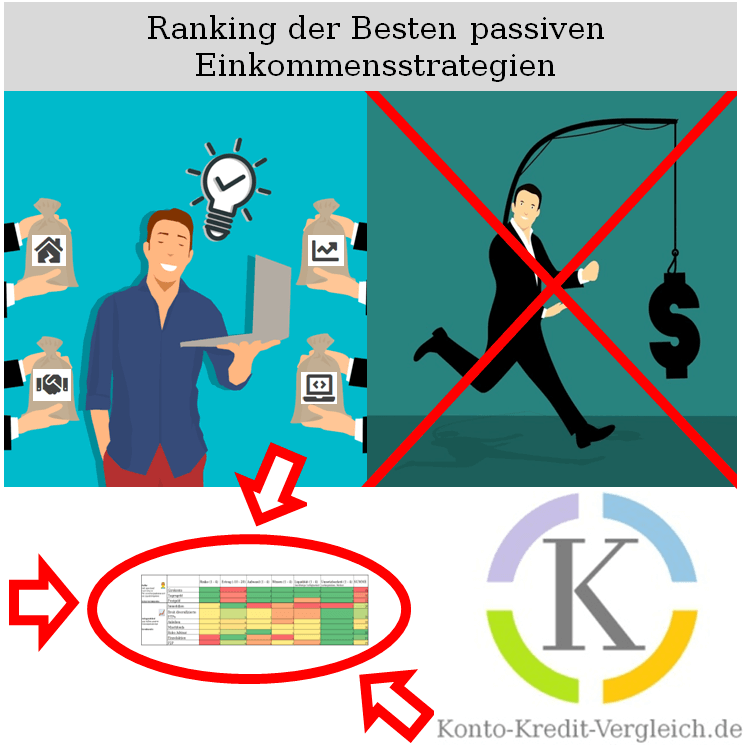



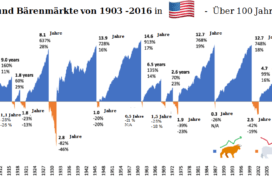



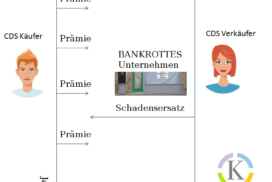





1 thought on “Passives Einkommen: Die 8 Besten Strategien! (Ranking)”